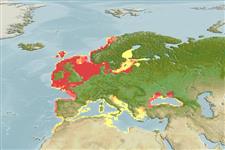分類 / Names
俗名 | 同種異名 | Catalog of Fishes(屬, 種) | ITIS | CoL | WoRMS | Cloffa
Teleostei >
Clupeiformes (Herrings)
鯡形目 (Herrings) >
Clupeidae (Herrings, shads, sardines, menhadens)
鯡科 (Herrings, shads, sardines, menhadens)
Etymology: Sprattus: Old German, sprotte (1611) = a small fish, Clupea sp. (Ref. 45335).
More on author: Linnaeus.
Issue
The subspecies were not characterized well enough, that unless there is more evidence presented in the future, Sprattus sprattus should be considered as one species with several known populations (S.Kullander, pers.comm. 07/09).
Environment: milieu / climate zone / depth range / distribution range
生態學
海洋; 半鹹淡水; 海洋洄游的 (Ref. 51243); 深度上下限 10 - 150 m (Ref. 6302). 溫帶; 69°N - 30°N, 11°W - 42°E
Northeast Atlantic: North Sea and adjacent waters as far north as the Lofoten Area and the west of the British Isles, and Baltic Sea south to Morocco; also in northern Mediterranean (Gulf of Lion and the Adriatic Sea) and Black Sea.
東北大西洋: 北海與波羅的海南至摩洛哥; 也地中海, 亞得里亞海的與黑海。
Length at first maturity / 大小 / 重量 / 年齡
Maturity: Lm 10.1, range 8 - 12 cm
Max length : 16.0 cm SL 雄魚/尚未辨別雌雄; (Ref. 188); common length : 12.0 cm SL 雄魚/尚未辨別雌雄; (Ref. 188); 最大年齡: 6 年 (Ref. 3561)
背棘 (總數) : 0; 背的軟條 (總數) : 13 - 21; 臀棘: 0; 臀鰭軟條: 12 - 23. Lower jaw slightly projecting, gill cover without any bony radiating striae, teeth rarely present on vomer; belly with a strong keel of scutes; last two anal fin rays not enlarged. No dark spots on flanks. Pterotic bulla absent.
下頜些微突出, 沒有任何的多骨放射陷紋的鰓蓋 , 齒很少地位於犛骨之上; 腹面有一個鱗甲的強龍骨脊; 最後兩個臀鰭棘條不增大了。 沒有在側面上的深色斑點。 翼的文件印章不存在。
Usually inshore schooling, sometimes entering estuaries (especially the juveniles) and tolerating salinities as low as 4 ppt. Shows strong migrations between winter feeding and summer spawning grounds. Moves to the surface at night. Feeds on planktonic crustaceans (Ref. 9900). Spawns at depths of 10-20 m producing 6,000-14,000 pelagic eggs (Ref. 35388). Some spawn almost throughout the year, mainly in spring and summer, near the coast or up to 100 km out to sea, the young drifting inshore. Sold as 'brislings' to canneries. Sprat are used in the production of fish meal and as mink food, less for human consumption (Ref. 9900). Utilized fresh, smoked, canned and frozen; can be pan-fried and broiled (Ref. 9988).
通常近海群游性, 有時進入河口 (尤其稚魚) 與容忍鹽度更低到 4個 ppt。 在冬天之間顯示強烈的迴游進食與夏天產卵場。 移動到表面在晚上。 吃浮游性甲殼動物。 (參考文獻 9900) 產卵在深度 10-20 公尺生產 6,000-14,000個大洋性的卵。 (參考文獻 35388) 一些產卵幾乎全年度,主要在春天與夏天, 在海岸或向上到 100 的附近公里向外到海洋, 幼魚漂流沿海地區。 賣作了到罐頭工廠的 '小鯡魚' 。 鯡魚被用於魚粉與當作貂的食物,比較少的供人類消費的生產。 (參考文獻 9900) 生鮮使用,煙燻了, 罐裝及冷凍; 可能是油鍋炸而火烤的。 (參考文獻 9988)
Some spawn almost year round but mainly in spring and summer, near to the coast or up to 100 km out to sea, the young drifting inshore. Individual period of spawning takes about two months (Ref. 92054).東北大西洋: 北海與波羅的海南至摩洛哥; 也地中海, 亞得里亞海的與黑海。
Whitehead, P.J.P., 1985. FAO Species Catalogue. Vol. 7. Clupeoid fishes of the world (suborder Clupeoidei). An annotated and illustrated catalogue of the herrings, sardines, pilchards, sprats, shads, anchovies and wolf-herrings. FAO Fish. Synop. 125(7/1):1-303. Rome: FAO. (Ref. 188)
人類使用
漁業: 高經濟性; 誘餌: usually
工具
特別的報告
下載 XML
網路資源
Estimates based on models
Preferred temperature (Ref.
123201): 4.3 - 15.3, mean 9.5 °C (based on 530 cells).
Phylogenetic diversity index (Ref.
82804): PD
50 = 0.5312 [Uniqueness, from 0.5 = low to 2.0 = high].
Bayesian length-weight: a=0.00575 (0.00491 - 0.00675), b=3.09 (3.04 - 3.14), in cm total length, based on LWR estimates for this species (Ref.
93245).
營養階層 (Ref.
69278): 3.0 ±0.07 se; based on food items.
Generation time: 2.2 (1.7 - 2.6) years. Estimated as median ln(3)/K based on 23
growth studies.
回復力 (Ref.
120179): 中等的, 族群倍增時間最少 1.4 - 4.4年 (rm=1.7; K=0.14-0.77; tm=1-2; tmax=6; Fec=2,000 (batch fec)).
Prior r = 0.48, 95% CL = 0.32 - 0.72, Based on 17 full stock assessments.
Fishing Vulnerability (Ref.
59153): Low vulnerability (25 of 100).
Climate Vulnerability (Ref.
125649): Low vulnerability (15 of 100).
Nutrients (Ref.
124155): Calcium = 69.8 [34.7, 136.5] mg/100g; Iron = 0.454 [0.171, 1.290] mg/100g; Protein = 19.9 [17.2, 22.6] %; Omega3 = 0.601 [0.328, 1.136] g/100g; Selenium = 8.55 [3.88, 18.40] μg/100g; VitaminA = 66.3 [13.8, 248.5] μg/100g; Zinc = 0.429 [0.200, 1.835] mg/100g (wet weight); based on
nutrient studies.
